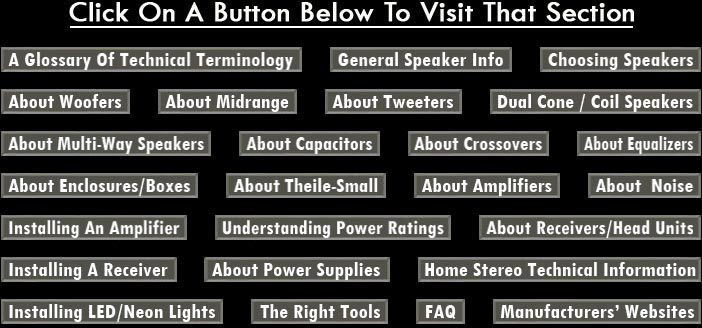


Watts
A measurement of power. In speakers, wattage is a term that indicates power-handling characteristics in dealing with electrical voltage inputs from the amplifier. RMS or continuous power handling is the only accurate basis for comparing the capabilities of Drivers. In determining the proper power input for a speaker, use this measure only. So-called Peak Power handling is often only the manufacturers best guess at the power dissipation point, beyond which the unit will fail.
WAV
A format for sound files developed jointly by Microsoft and IBM, and built into Windows 95 to XP which made it the de facto standard for sound on PCs. WAV sound files end with a.wav extension and can be played by nearly all Windows applications that support sound.
Wave
A single oscillation in matter (i.e., a sound wave). Waves move outward from a point of disturbance, propagate through a medium, and grow weaker as they travel farther. Wave motion is associated with mechanical vibration, sound, heat, light, etc
Waveform
The waveform of a signal is a depiction of its instantaneous voltages versus time. In audio, for example, we are always dealing with periodic waveforms that make up what we hear. These periodic waveforms can be plotted on a graph and will show up as some type of squiggly line. The graph chart rom left to right represents time and from top to bottom is the amplitude of the sound or voltage at those points in time. The familiar sine wave is an example of this.
Wavelength
The distance between one peak or crest of a sine wave and the next corresponding peak or crest. The wavelength of any frequency may be found by dividing the speed of sound by the frequency.
Wave Table Synthesis
A technique for generating sounds from digital signals. Wave table synthesis stores digital samples of sound from various instruments, which can then be combined, edited, and enhanced to reproduce sound defined by a digital input signal. Wave table synthesis reproduces the sound of musical instruments better than Frequency Modulation (FM) synthesis.
Weighting
When laboratory measurements are taken of audio gear, the literal, "true" figures obtained often do not reflect the anomalies introduced by human perception. In these cases, the measurements obtained may be mathematically modified, or "weighted" to take into account the peculiarities of human hearing. A common example is "A-weighting", a curve applied to sound pressure levels to more accurately reflect our loudness perception. Other types of weighting compensate for the ear's frequency response, distortion tolerance etc.
White Noise
Random noise with equal energy per frequency is called white noise. It tends to sound very bright and "hissy" due to the unique characteristics of the human ear's frequency response curve. Each ascending octave contains twice as many frequencies as the next lower one, resulting in a significant "build up" of energy in the higher octaves.
Wide-Bit Stream Processing
This technology maintains 20-bit precision through the recording process, for clearer reproduction of delicate, low-level music.
Windings
The wire in a voice coil that is wound around the former (also called a bobbin) to create a coil. Generally, any coils in a transformer, motor, or as an inductor.
Woofer (Subwoofer)
The bass and lower midrange sounds are reproduced by the woofer. To operate efficiently, a woofer's cone should be made of material that is stiff, yet lightweight. Cones made of polymers, polypropylene, light metals, or poly mixed with other materials including carbon strands and metals, provide excellent sound, and stand up to the heat, cold and moisture that car speakers face daily. Paper cones treated for moisture resistance also do a good job, and are usually very efficient. For car usage, untreated cones should be avoided.
The term "Subwoofer" came into common parlance as a result of the need for marketing departments to boost the "heavy hitting" image of their woofer products. Most such subwoofers are more dependent on the accompanying electronics than on the woofer itself. It was a campaign so successful, it is now as difficult to find a woofer as it is to find a "regular strength" antacid tablet. But as far as describing a particular type of Driver, the term is virtually worthless. The ludicrous extent to which the trend has gone is illustrated in the recent appearance of 4 inch "subwoofers."
Study the ratings, specifications, and construction of any woofer you are considering, to see if will be appropriate for your system. In constructing your system, remember to start with the goal first, then the woofer and enclosure, and finally, the amplifier. Everything must work together, and fit together as one coherent system, if you are to be successful.
One area in which the term "subwoofer" does have some authentic application is in the popularity of dedicated low range speakers called powered subwoofers (usually incorporating an amplifier and Crossover) that are used with home-theatre systems to boost the low-end response.
Wow
Wow is a relatively slow variation in the frequency of reproduced sound caused by slow speed variations in records, tape recorders, etc. Pitch fluctuations of one or two per second are classified as wow, while more rapid variations are called flutter. In specifications wow is usually rated, along with flutter, as a percentage of pitch deviation produced by these two phenomenon in a tape or phonograph machine.















